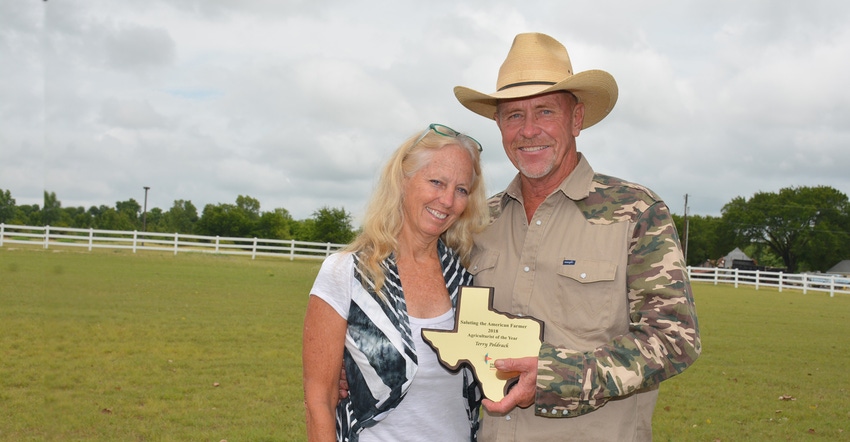
Terry Poldrack was tired of the middleman getting his money. The Williamson County, Texas, corn, wheat, and cattle producer has spent his farming career looking for opportunities to hold on to more of his earned income.
As a result, services he began to provide for himself eventually branched into small businesses, earning additional income and Williamson County’s Agriculturist of the Year award.
“He’s been an innovator,” says Bob Avant, Williamson County Farm Bureau president and director of corporate relations for Texas A&M AgriLife Research. “He was one of the first people in the county to get an 18-wheeler, so he could better market his grain and take it directly to port. He also went into using a TerraGator and other big equipment for application of chemicals and heavy equipment for terraces and clearing land. And most recently, working in the area of wild hog control — a very diverse operation.”
Poldrack was presented the award by Avant at the 2018 Stiles Farm field day at Taylor, Texas, in June.
A Williamson County native, Poldrack moved to the farm when he was 16. By the time he graduated from high school he had purchased his first tractor, rented his first farm and with his father Melvin Poldrack, begun a custom baling business. While his dad also had a fulltime job off the farm, when offered the chance to work with him, Terry said he chose to stay on the farm.
“I love being my own boss, so I stayed. He and I still farm together.”
Terry also works with his son Hunter Poldrack who he says is a very intricate part of the operation. “We are lucky to have his expertise, knowledge and endless energy,” says his proud father.
When Terry isn’t farming, he’s growing his other businesses. In the 1980s, Terry and Melvin purchased a truck to haul their grain directly to Houston.
“I would combine all day, jump in a truck at 10:30 p.m., run to Houston, sleep in the line, dump and come back by 11:30 a.m. the next day and be back on the combine.”
Then, tired of waiting on their crops to be sprayed, Terry and Melvin purchased a TerraGator. Today, they own three. “We spray thousands of acres commercially. It grew out of a need of our own.”
And by 1989, they had bought their first dozer. “It was real dry that year. We bought a dozer to clean out our own tanks and then did some work for friends and neighbors. We got another dozer and now we have 10 various types of heavy equipment. We do all kinds of dirt work.”
Going Hog Wild
But not all of Terry’s business ventures are generated at ground level. For the last twelve years, he and pilot Ross Thompson of Uvalde, have been trying to suppress the growing wild pig population in Williamson County from the air.
While Thompson flies his Bell R-22 helicopter, Terry is armed with a 12-gauge automatic shotgun and eight loaded magazines searching for groups of wild hogs.
“We’re not controlling them, we’re holding them down,” says Terry, who, along with two other shooters, once shot 1,000 hogs in four days. “They’re so prolific, they just keep coming.”
Texas is estimated to have 5.3 million wild hogs, according to Dr. John Tomecek, assistant professor and Extension wildlife specialist, Department of Wildlife and Fisheries Sciences, Texas A&M AgriLife Extension Service. “Last year in Texas, damages on small grain production and grain production, were about $125 million, just for pigs. And that number has been steadily increasing,” he said during his Stiles Farm field day presentation.

Williamson County’s Agriculturist of the Year Terry Poldrack, left, with the Ag Business Professional of the Year Larry Sladek.
In a freshly planted corn field, Terry says it’s not unusual for wild hogs to “knock out” a 50-acre field in one night. “Every time you replant, you’re getting later in the season, you’re getting closer to the hot weather and then it won’t pollinate right, like where we are at this year. So, they ‘re just a problem.”
Once a group of landowners gets together and signs the legal paperwork through the Texas Parks and Wildlife, Terry and his pilot will fly their land. He says they’ll go up with enough gas to fly for about an hour and fifteen minutes. “The less gas we take, the more maneuverable the helicopter is, so you are always watching the gauge. A lot of times, one time up, I’ll kill 100 hogs and I’m out of ammo before we get back.
“Even after all we’ve done, there’s plenty hogs around.”
In two years, says Tomececk, one sow has the potential to reproduce and produce about 50 new pigs. “It’s to the point now, where we would have to kill about two-thirds of the pigs that are out there every single year to keep numbers where they are. But we only get a third of them.”
Cattle Backgrounding
Terry and Melvin also have 1,000 to 1,100 momma cows. “We don’t sell our cattle through livestock auctions, we background them ourselves. We put them back on wheat or coastal Bermuda pasture until they are ready for Hunter to haul them to a feedlot in Dumas, Texas,” he says.
True gratification
When asked what motivates Terry, he says there’s just something gratifying about seeing a good crop or set of calves. The best part? Having his wife and four grandkids with him when possible. “It’s fun to have them with me and I encourage them to participate and help whenever they can. If you had a job somewhere else, they couldn’t go to work with you.”
Also presented at the Stiles Farm field day was the Ag Business Professional of the Year award, which was given to Larry Sladek of Taylor. Both awards were sponsored by Farm Bureau.
About the Author(s)
You May Also Like






